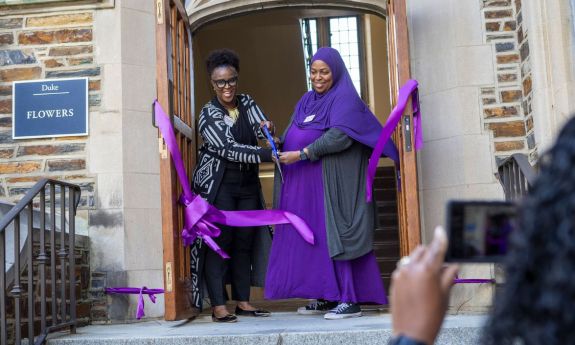A Joyful, Musical Reopening of the Mary Lou Williams Center in Flowers Building
Center for Black culture returns to renovated, upgraded space

“It’s truly a welcoming place for our students and anyone who chooses to visit,” the center’s director Stacia Williams said before the reception to a backdrop of live jazz.
The Lou was named to honor the jazz pianist, composer and arranger Mary Lou Williams, a musical giant who was playing with Duke Ellington at the age of 13 and also counted Benny Goodman among her peers.
Williams was a child prodigy and one of the art form’s greatest innovators. She was known as “the lady who swings the band,” served as a teacher and mentor for the architects of bebop, Charlie Parker, Thelonious Sphere Monk, Dizzy Gillespie and Miles Davis.
Williams arrived at Duke in 1977. She was the university’s first artist-in-residence and served as director of the jazz ensemble until her death in 1981.

The Lou opened on the first and second floors of the Flowers Building in 1983 and soon became “a hub for community building, learning, exploration and community development,” Solomon said.
“This space has a rich history within our campus and since its founding …is [a place] that should provide a safe and affirming space, and support for the diversities of Black-identifying people here at Duke University,” she added.
Marc Lee, site coordinator and public historian at the Hayti Heritage Center in Durham, the celebration’s keynote speaker, talked about having a direct connection to Williams’ legacy “and what Mary Lou Williams was all about,” because his parents Jim and Valeira Lee, co-founded in 1976 one of the few Black public radio stations in the country, WVSP.FM – for Voices Serving People – in Warrenton, North Carolina, about 57 miles from Duke.
“My parents had a great deal of respect for Mary Lou Williams, and how influential she was here in the jazz community,” Lee said.
Lee also described the Hayti Heritage and Mary Lou Williams centers as “sister organizations” that tell the stories of the connections between Duke and the city’s African American community.
Lee noted that Durham activist Howard Fuller in the late 1960s joined with activist Black students on Duke’s campus and started Malcolm X Liberation University in the 400 block of South Pettigrew Street, to offer Black students a more relevant and meaningful curriculum.
Lee said in recent years, he enjoyed visiting the Lou to take in performances by Duke’s jazz studies program anchored by John Brown, Duke’s vice provost for the arts, and director of the school’s jazz studies program.
“So I’m looking forward to going back there and I’m telling my friends already,” he said. “And we’re looking forward to being in that space and seeing some of the young jazz lions that are coming up.”
Still, at the beginning, middle and end of the day, the Lou, in the words of Solomon, is “safe, affirming space,” particularly for Black and African American students who account for a little over seven percent of Duke’s student population.

Joseph Asamoah-Boadu is a Mary Lou Williams Center ambassador and incoming president of the school’s Black Student Alliance. For the past 18 months, he and his classmates who hung out at the Mary Lou Center, held tight to “the spirit of the Lou.”
Asamoah-Boadu said he was devastated by the flooding that closed the Lou, which he said became a second home for him and his fellow classmates.
Asamoah-Boadu said spirit of the Lou traveled with them during the center’s temporary relocation to the Bryan Center.
“We learned to embrace what we had,” he said. “We shared the same laughs, accomplishments and tears in the midst of uncertainty and unfamiliar territory; the spirit of the Lou prevailed. The spirit is in all of us.”
During an unsettling period when values like diversity, equity, inclusion and public education itself is under undue attack, Asamoah-Boadu shared what makes spaces like the Lou so invaluable.
“I want to remind you that the spirit in the Lou is inclusive [and] welcoming to all…and belonging to every member of our community, no matter where they come from, or what their background may be,” he said, “let’s continue to build on the legacy…embracing diversity and fostering a sense of belonging.”
